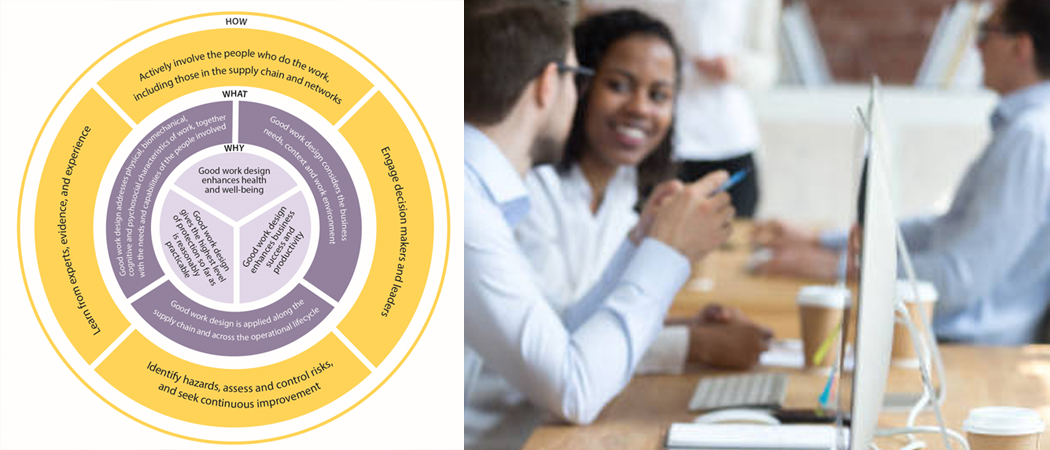Getting Healthy work design right
Be confident, get it right and a psychologically safe workplace benefits everyone. Yes, good work design really does protect workers from psychological injury and illness. It also improves morale, increases productivity, and lowers your business’ running costs.
Importantly, addressing safe and healthy work through design is actually a national priority in the Australian Work Health and Safety Strategy 2012-22.
Let’s focus on good work design where international research consistently shows that good work design can:
- protect workers from harm to their health, safety and wellbeing and your business from the costly impact from this.
- significantly improve workers health and wellbeing, increasing their job satisfaction, improving staff retention and your bottom line.
- ultimately improve innovation, business success and productivity.
- better support the lives of workers, their families, and communities.
So…what is Healthy work design?
Too often, the way people work has evolved over time without much conscious design. It’s only when poor work design results in significant psychological injuries, an increase in errors or complaints, or abnormally high turnover of staff, that leadership teams begin to ask why.
Healthy work design protects the psychological health and safety of any workforce. This means, where predictable, hazards and risks are removed or minimised and the wellbeing and job satisfaction of workers is prioritised. To realise the most effective outcomes for your business you need to regularly consider good work design principles in the planning and design process.
Safe Work Australia explains what you need to consider when designing good (healthy) work:
Examples of Healthy, safe, work design
These examples of good, safe, work design will prevent physical and psychological illness and injuries.
- The workflow is smooth and the right equipment and technologies are available for all workers.
- Work stations are ergonomically adjustable and work demands are manageable.
- Communication from management and co-workers is respectable & clear.
- There are clear expectations about work duties and processes are applied consistently across the entire workforce.
- A professional with a manageable workload & appropriate job demands, high job autonomy, and consistent demands from managers.
- An office worker working reasonable shifts with the right furniture and physical environment.
- An employee’s work is appropriately timed that meeting targets is reasonable and achievable.
- An employee’s equipment is suited to the task, available, and correctly maintained, posing minimal stress and safety risks.healthy
The How to Healthy work DESIGN
Healthy work design considers the physical work environment, work roles and tasks, and the physical, emotional and psychological wellbeing of workers.
The process
- Identify the context of the work
Think about the location, physical environment limitations and constraints, workforce composition, and background. - Consider the entire operation by studying the tasks performed by workers and the variety of work undertaken
Identify possible gaps between the psychological demands of the work as imagined (i.e. work described/prescribed in documentation or communicated verbally) and the work as it is actually being done. - Analyse the resource requirements (task components) of work
Think about the physical, mental and emotional capabilities of your workers and address the work’s:- physical characteristics (e.g. chemical hazards)
- biomechanical characteristics (e.g. manual task demands)
- cognitive characteristics (e.g. mental complexity)
- psychosocial characteristics (e.g. feedback, autonomy).
- Develop and implement solutions
It is critical that a representative mix of people across your business and supply chain are brought together to, not only identify all of the issues but also, consider new and improved designs and solutions to address the issues/gaps/risks that have been identified. - Good work design is a continuous journey
This requires astute leadership within organisations who are prepared to continually monitor, review and innovate.
We probably don’t have to tell you that your workplace is unique. There’s not a one size fits all approach to psychologically safe work design. A great place to start is to visit Safe Work Australia’s ten principles of good work design where they identify how to apply these principles to any workplace, business or industry.

REVIEW the Health of YOUR WORKPLACE DESIGN
HR and business leaders very often find it far more efficient and cost effective to employ external experts to better safeguard their employees and organisation from the threat of psychosocial hazards. Finding a tailored solution, including designing healthier work, to protect your workplace can actually be very easy and cost effective. If you’d like to explore the best strategy to minimise your organisation’s exposure to psychosocial hazards reach out to us.


